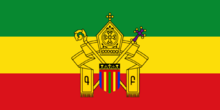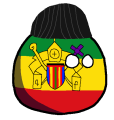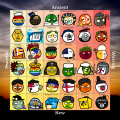Script error: No such module "Mbox".
State Oriental Orthodoxy is an Authoritarian Unity ideology that believes that Oriental Orthodoxy should be the state religion and the religion and state should help each other on issues but not interfere with each other. He is very religious, despises Muslims, and has a mixed relationship with his brother.
History
Kingdom of Armenia
It all started back in the Kingdom of Armenia with Tiridates III the Great. He had taken back the kingdom from Sassanid occupation with the help of Roman armies. Christianity was spreading in Armenia thanks to Gregory the Illuminator. Tridates arrested Gregory (partly because he was the son of his father) under the Khor Virap church. He was released in 297 to help Tridates after he lost sanity because he was betrayed by the Roman emperor Diocletian who invaded a vast amount of territory from the kingdom. In 301 Gregory baptized Tiridates III along with members of the royal court and upper class as Christians. Tiridates issued a decree by which he granted Gregory full rights to begin carrying out the conversion of the entire nation to the Christian faith. The same year Armenia became the first country to adopt Christianity as its state religion. Gregory continued to strengthen Christianity in the empire until he died in a small sanctuary near Mount Sebuh in the Daranali province. In 387, the Kingdom of Armenia was split between the Eastern Roman Empire and the Persian Empire. Western Armenia was given to the Eastern Romans and Eastern Armenia was given to the Sassanids. Eastern Armenia remained a kingdom within Persia until 428, when the local nobility overthrew the king, and the Sassanids installed a governor in his place.
Bagratid Kingdom of Armenia
After hundreds of years of Roman, Persian, and Arab rule, Armenia finally regained Independence in the 880's as Ashot I became the first king since 428. Oriental Orthodox Christianity was then resorted as the state religion. During this time period, the kingdom would not just have trouble with outside and internal conflict, but also with religious conflict as there was a heretical christian sect called the Tondrakians. They were anti feudal and were spreading around Armenia after the Arabs crushed them. Ashot III had realized the danger the Tondrakians posed against the kingdom and this was of his reasons why he directly subjected the Church to him, gave it lands, and sponsored the construction of new monasteries and churches. The message of the Tondrakians, however, continued to spread and successive Armenian kings would work to suppress its expansion. Another issue that arose was that the power relationship between catholicoi and secular rulers was sometimes a source of conflict. In 1037 king Hovhannes-Smbat of Ani deposed and imprisoned Catholicos Petros, who he suspected of holding pro-Byzantine views, and appointed a replacement catholicos. This persecution was highly criticized by the Armenian clergy, forcing Hovhannes-Smbat to release Petros and reinstall him to his former position. In 1038 a major ecclesiastical council was held in Ani, which denied the king the right to elect or remove a catholicos. Eventually in 1045 the kingdom fell and it split up into three kingdoms: The Kingdom of Syunik, The Kingdom of Tashir-Dzoraget, and The Kingdom of Artsakh (which we will talk about next).
Kingdom of Artsakh and Principality of Khachen
WIP
Kingdom of Aksum
WIP
Beliefs
State Oriental Orthodoxy believes that Oriental Orthodox Christianity should be the official state religion of the state. In this state the religion and government would help each other sometimes. Priests and the such would give advice to the government and the priests would rely on the governments patronage and contributions. The government would also help out whenever the religion is having a dispute.
Personality and Behavior
State Oriental Orthodoxy is very religious. He is often seen praying, reading religious texts, and preaching to get new converts. He also despises Muslims. Whenever he sees a Muslim he always says something behind their back or even gets confrontational with the Muslim. He also has a mixed relationship with his brothers. They always see each other as apostolic church buddies until someone brings up the council of chalcedon. After that, everything gets VERY tense.
How to Draw

- Draw 3 thick lines of (from top to bottom) #018A2C, #FDE740, and #DB0A13
- Draw the symbol that's on the Logo of Armenian Apostolic Church with the Coptic Coat of Arms in the middle of the 2 staffs
- Draw a Coptic Priest hat (an "emma")
- Draw eyes and you're done!
Relationships
Friends
 Christian Theocracy - Christian brothers!
Christian Theocracy - Christian brothers! Traditionalism - We must hold to the values that God gave us.
Traditionalism - We must hold to the values that God gave us. Orthodox Theocracy - Based Orthobro. The Byzantine Empire was good while it lasted, so I built the church of Lihebella church to impress you.
Orthodox Theocracy - Based Orthobro. The Byzantine Empire was good while it lasted, so I built the church of Lihebella church to impress you. Manichaeism - Although I dislike how this religion originated from Persia, it recognizes Ethiopia as the mighty regional realm.
Manichaeism - Although I dislike how this religion originated from Persia, it recognizes Ethiopia as the mighty regional realm. Titoism Non-Aligned brother. (And nice work with the Catholic Ustašas)
Titoism Non-Aligned brother. (And nice work with the Catholic Ustašas)
Frenemies
 Catholic Theocracy - I will thank my fellow Portuguese brothers for saving us from
Catholic Theocracy - I will thank my fellow Portuguese brothers for saving us from  him, but stop trying to convert me. I will not be Catholic!!
him, but stop trying to convert me. I will not be Catholic!!
Enemies
 Fascism - Go back to Italy!
Fascism - Go back to Italy! Islamic Theocracy - I tolerated your religion in Abyssinia and allowed your God to come seek refuge from Arabiya, why do you want to kill me?!
Islamic Theocracy - I tolerated your religion in Abyssinia and allowed your God to come seek refuge from Arabiya, why do you want to kill me?! Zoroastrian Theocracy - Curse you, Farsi! You persecuted Christians in Armenia and prevented Ethiopia from expanding Christianity into Yemen!
Zoroastrian Theocracy - Curse you, Farsi! You persecuted Christians in Armenia and prevented Ethiopia from expanding Christianity into Yemen! Reactionary Socialism - No, we will not be a colony in your empire!
Reactionary Socialism - No, we will not be a colony in your empire! Maybe if you were a colony in ours... Derg - Even worse than above. You are also a puppet of
Derg - Even worse than above. You are also a puppet of  the red imperialists.
the red imperialists. Jewish Theocracy - Gudit!
Jewish Theocracy - Gudit!
Further Information
Gallery
Portraits and Artwork
-
-
"Theocracies compass" By Spade
| | |

